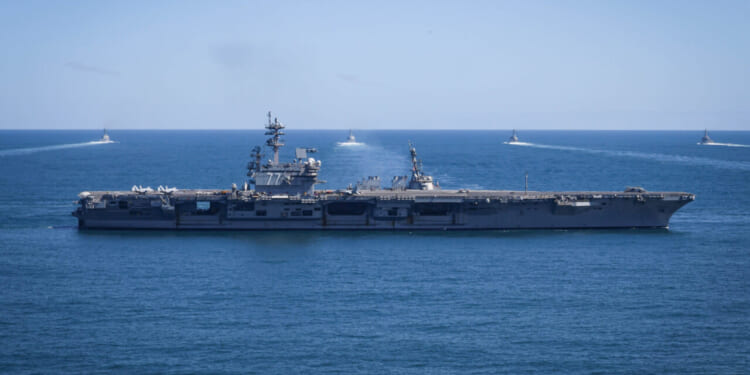As the world’s leading “floating airport” design, the Nimitz carriers can carry around 60 airframes.
As tensions between Beijing and Washington continue to mount, the Trump administration has dispatched two of the Navy’s aircraft carriers near China. Both the Nimitz and George Washington Carrier Strike Groups (CSG) are currently operating in the Western Pacific. A US Seventh Fleet spokesperson said that the two Nimitz-class boats were carrying out “routine operations” within the fleet’s area of operations.
However, the Chinese People’s Liberation Army Navy (PLAN) has recently showcased improvements being made to its upcoming Fujian carrier. In September, Beijing released imagery depicting the Fujian’s ability to launch and recover aircraft from its flight deck, making the carrier the first-ever catapult-equipped warship in the fleet. While the United States still greatly outpowers and outnumbers China’s aircraft carrier contingent, the PLAN is continuing to expand and advance, posing a threat to American interests globally.
Both USS Nimitz and USS George Washington represent the first and sixth carriers in the Nimitz-class. The Nimitz was initially dispatched to the Middle East to join the Carl Vinson CSG when the carrier set sail on its scheduled deployment over the summer. However, the ongoing ceasefire between Israel and Hamas may have freed up the Navy’s carrier positioning strategy. The USS George Washington is homeported in Japan and often rotates its Pacific operations with its West Coast-based Nimitz-class sister ships. In total, 10 Nimitz carriers are in service today. Up until the introduction of the USS Gerald R. Ford in 2017, the Nimitz carriers were the largest warships ever built and in service.
America’s Mighty Nimitz-class Carrier
The 10 Nimitz nuclear-powered aircraft carriers that serve the Navy today were named to honor World War II US Pacific Fleet commander and Fleet Admiral Chester W. Nimitz. Each ship was built by Newport News Shipbuilding Company in Virginia, beginning with USS Nimitz roughly half a century ago. Over the next three-plus decades, Dwight D. Eisenhower, Carl Vinson, Theodore Roosevelt, Abraham Lincoln, George Washington, John C. Stennis, Harry S. Truman, Ronald Reagan, and George H.W. Bush also launched.
As the world’s leading “floating airport” design, the Nimitz carriers can carry around 60 airframes, including a variety of fixed-wing and rotary-wing aircraft with up to 90 different types. Notably, the Nimitz carriers are equipped with steam catapults, which enable supporting airframes to land and take off on their shorter flight decks. As explained by Popular Mechanics, “Steam is diverted from the ship’s boilers—steam boilers powered by the ship’s nuclear reactors—and piped up to just under the flight deck, where it is held and pressurized in special tanks. In the meantime, the front landing gear of a carrier aircraft is loaded onto a small, plate-sized shuttle. When the aircraft is ready for launch, the steam is suddenly released and, in a burst of power, accelerates the shuttle—and attached aircraft—down the flight deck to takeoff speeds.” While the steam catapult provides impressive sortie rates, the newer Ford-class successors possess the more advanced Electromagnetic Aircraft Launch Systems (EMALS) to launch aircraft. Until these carriers are all introduced to service, however, the Nimitz ships will continue to dominate the seas.
About the Author: Maya Carlin
Maya Carlin, National Security Writer with The National Interest, is an analyst with the Center for Security Policy and a former Anna Sobol Levy Fellow at IDC Herzliya in Israel. She has by-lines in many publications, including The National Interest, Jerusalem Post, and Times of Israel. You can follow her on Twitter: @MayaCarlin. Carlin has over 1,000 articles published over the last several years on various defense issues.
Image: DVIDS.


















